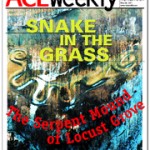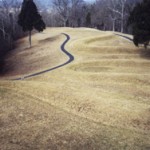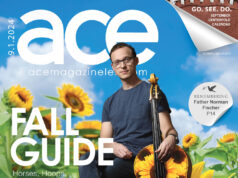Ace May 24, 2001. Photos and story by Erik Reece
BY ERIK REECE
 It may be the most important serpent mound in the United States, but from ground level, it looked like, um, a golf course. I almost expected to see well-groomed men in polo shirts driving carts along the blacktop path that rings the mounds of undulating earth.
It may be the most important serpent mound in the United States, but from ground level, it looked like, um, a golf course. I almost expected to see well-groomed men in polo shirts driving carts along the blacktop path that rings the mounds of undulating earth.
Why am I here in Ohio, standing at the corner of Serpent Mound’s parking lot? For starters, it is, as of January 24th, the Chinese Year of the Snake, a year devoted to “introspection, planning, and seeking,” according to one Taoist almanac I consulted (risky investments and right-wing politics are discouraged). Secondly, this is the one hundredth anniversary of Frederic Ward Putnam’s bequest of Serpent Mound to the state of Ohio. Putnam, a Harvard archaeologist, began restoring the mound in 1887. Finally, it is a rare, warm February day and I have driven up from Lexington, Kentucky, where another Adena tribe – the first North Americans to bury their dead in mounds – once lived. There is one such mound here too, but the massive serpent is the story. Nowhere else in North America does such an impressive pre-Columbian, animal earth-work exist. Covered in the ochre-green grass of winter, Serpent Mound rises about five-feet-high, is twenty-feet-wide, and winds for nearly a quarter-of-a-mile. The mound is largest at the reptile’s mouth, while its tail slowly dwindles into a foot-high coil near where I am standing.
There is no one else here today besides the park attendant, who graciously offers to unlock the museum for me, which isn’t supposed to open until April.
The museum, really a small log cabin, features a skeletal replica of what the mound would look like were it a real (a real dead) serpent. Also on display are crude tools and arrowheads the Adena people made, and interesting cross-sections of the burial mound.
Back outside, there stands what looks like an old fire-tower, built near the tail to give visitors an aerial view of the serpent. But even thirty feet up, it is hard to take in, hard to appreciate, the magnitude of this effigy. The head is still too far away to b

e seen. I climb back down the stairs and begin to follow the path around the mound.
The serpent winds along the top of a narrow limestone-and-shale bluff; its triangular head marks the point of the ledge and the place where, 150 feet below, the east and west forks of Brush Creek come together. Fifty-two miles away, it will empty into the Ohio River. As the ground dips, the curving mound almost seems to be holding the bluff together. And here is where the inevitable mythic resonances begin. This snake sprawls across the entire top of the ridge just as Vrtra, a serpent in Hindu mythology, wrapped itself around a cosmic mountain to hold back rushing water. Although the serpent on the whole hasn’t faired well in western monotheism, early Sumerian people thought it was a symbol of healing, and many later cultures associated the snake with Spring, with the coming of vegetation and a “blessed greenness.” And at Serpent Mound, such associations do win out over the trickster portrayed in the book of Genesis.
This Ohio serpent unfolds in seven languorous curves that inspired the great Japanese-American sculptor, Isamu Noguchi, to extend his notions of the sculptor’s material. He began designing a number of parks, all of which incorporated winding, mounded elements. Despite the “Please stay on the trail” signs, it takes a great deal of self-control not to simply rest my back against the lower crescent of the mound. I imagine hundreds of Adena people leaning like this, chanting, their spinal cords (another symbol of the snake) trembling like each of the serpent’s ribs.
Heal us. Bring back Spring. Make us whole.
A mature cedar stands nestled inside one of seven curves, before the mound finally forms a triangle that suggests open jaws. The serpent’s mouth seems to wrap around an oval mound, hollowed to earth-level in the middle, where a young redbud stands. Or is the oval simply the serpent’s head, the tree its eye in profile? Beyond the oval, a final, small mound flattens and comes to a quick point. Only aerial photographs and etchings done by 19th century archaeologists reveal the mound’s sinuous grandeur, while only close inspection show the sensuous accomplishment of its builders.
Who where they? Scholars differ on when the Adena tribe formed. The park’s official record says they appeared around 800 B.C.E. and disappeared at the end of the first century. They are closely associated with the nearby Hopewell mound builders and the Mississippian civilization who built temple mounds. The Adena were planters and gatherers, eating sunflowers, squash, and other native plants. They wore decorated loincloths and made coil pots from clay. Archaeologists have found bracelets of small stones on the wrists of skeletons inside the mounds. They also held athletic contests and gambled, as is evident from unearthed dice, carved from bones.
Serpent Mound was molded mostly from hard clay and set with stone in places where erosion was most likely. Radiocarbon dating estimates that the mound is just over 900 years old.
Why did the Adena people build it? Theories abound. Landon West, a Baptist minister from Pleasant Hill, Ohio, brassily declared Serpent Mound to be the Garden of Eden (it is after all in Adams Country). Apparently the serpent hung around Paradise after the First Family was evicted. Some more scholarly opinion says it is simply an ambitious emblem of the Adena tribe. Others claim the mound effigies served a religious function. Did the Adena worship this serpent? Do modern Christians think the Eucharist is the actual body of Christ?
The two men who discovered Serpent Mound in 1845, Squier and Davis, wrote, “The serpent, separate or in combination with the circle, egg or globe, has been a predominant symbol amoung many primitive nations. It prevails in Egypt, Greece, and Assyria, and entered widely into the superstitions of the Celts, the Hindoos, and the Chinese.” In eastern religion, the serpent is often shown biting its tail to symbolize the cyclical pattern of life and immortal reincarnation. That obviously isn’t what the Adena people had in mind. 
Some years later, the secretary of the Western Reserve Historical Society, John P. MacLean claimed to have discovered something Squier and Davis overlooked – the mounded figure of a frog leaping away from the oval. Working for the Smithsonian Institute, W.H. Holmes seemed to confirm MacLean’s theory when, in 1886, he made an etching that shows a wish-bone shaped mound on the other side of the oval. In many world mythologies, the frog is often a symbol of life – as the egg always is. Today, however, the precipice is too badly eroded and a stone look-out has been built there. I gaze down through the white branches of sycamore at the green river. It has settled back into its banks after a week of rain. If there was a frog, it has long sense vanished into Brush Creek. But either way, if one sees the oval as an egg, then Serpent Mound stands as an emblem of death devouring life, or put less harshly, “the life process.”
On the other side of the serpent, I follow a muddy trail that leads down one side of the bluff to Brush Creek. The varying strata of rock that form the scarp have made more than one explorer see in the bluff a human face, with its furrowed shale brow and harder limestone nose and chin. Such symbolism would fit nicely into Carl Jung’s psychology: If the stone walls form a hollow-cheeked face, then the serpent could be understood as a symbol lurking behind it, within Jung’s “collective unconscious.” One wouldn’t have to hypothesize that all of this serpent worship was brought across the Bering Straight when a narrow land-mass connected Siberia and Alaska 15,000-to-30,000 years ago. Jung would simply say the serpent is a symbol within everyone’s subconscious. As Jung studied ancient religions and interpreted his patients’ dreams, he found that the serpent was almost always associated with water, and thus with depths, mystery and darkness. Jung finally formulated a theory in which the serpent “completed” the Trinity by adding to it the “lower Adam,” or human instinct. Yet that lower self still possesses what the Gnostics called the “divine spark” and what the alchemists termed the lapis philosophorum – the philosopher’s stone. In ancient myths, snakes are often guardians of precious stones and precious knowledge. Is the oval such a stone? Is the redbud tree such a spark?
To my thinking, Jung’s theory does coincide with the religion of the last Mississippian mound builders, the Natchez. According to the editors of the Encyclopedia of American Indian Tribes, the Natchez believed the sun had sent a man and a woman to earth to teach humans how to live. The man was the younger brother of the sun and told his people to build a temple and place inside it a sacred fire that would never go out. I read the oval as that sacred fire, the philosopher’s stone: a portion of the sun that the serpent swallowed, connecting the heavens and earth.
The trail circles around the brow of the precipice under red maple and box elder, then ends back at the top, back on the other side of the serpent. Were it early Spring, the redbud in the center of the oval would bloom like the sacred fire of the Natchez temple.
When I locate the park attendant again, he is cleaning the restrooms. I ask what his theory is about the mound. He just shrugs, smiles, and says he doesn’t have one.
“Well there’s a young redbud in the place of an eye, so you must think the oval is its head,” I say.
“Aw,” he admits sheepishly, “we just planted that so people would talk about it.”
YOU MIGHT ALSO LIKE
UK Professor Erik Reece profiles Lexington for Garden and Gun Magazine, Ace August 2010
Holler if You Hear Me, Holler Poets by Bianca Spriggs, Ace, September 29, 2010







